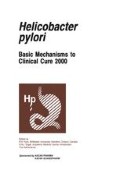Abstract
Helicobacter pylori is an extraordinarily common pathogen that has coexisted with humans since prehistoric times1. Yet the organism’s ascendancy in the human stomach may soon be at an end. Increasing evidence from industrialized Western nations indicates that human H. pylori infection is disappearing at a dramatic rate. In longitudinal studies from the US, Europe and Japan, H. pylori prevalence has demonstrated precipitous drops, at rates exceeding 25% per decade2–7. These decreases appear to have been more precipitous in children than in adults. Anecdotally, many paediatric gastroenterologists claim H. pylori to be a rarity among their patients. At our own hospitals at Stanford, H. pylori infection is harder and harder to find. In parallel with this drop in H. pylori infection are corresponding decreases in gastric cancer and in duodenal ulcer disease.
Access this chapter
Tax calculation will be finalised at checkout
Purchases are for personal use only
Preview
Unable to display preview. Download preview PDF.
References
Covacci A, Telford JL, Del Giudice G, Parsonnet J, Rappuoli R. Holicobacter pylori virulence and genetic geography. Science. 1999;284:1328–1333.
Parsonnet J, Blaser MJ, Perez-Perez GI, Hargrett-Bean N, Tauxe RV. Symptoms and risk factors of Helicobacter pylori infection in a cohort of epidemiologists. Gastroenterology. 1992;102:41–46.
Sipponen P. Helicobacter pylori gastritis — epidemiology. J Gastroenterol. 1997;32:273–277.
Roosendall R, Kuipers EJ, Buitenwerf J et al. Helicobacter pylori and the birth cohort effect: evidence of a continuous decrease of infection rates in childhood. Am J Gastroenterol. 1997;92:1480–1482.
Replogle ML, Kasumi W, Ishikawa KB et al. Increased risk of Helicobacter pylori associated with birth in wartime and postwar Japan. Int J Epidemiol. 1996;25:210–214.
Haruma K, Okamoto S, Kawaguchi H et al. Reduced incidence of Helicobacter pylori infection in young Japanese persons between the 1970s and the 1990s. J Clin Gastroenterol. 1997;25:583–586.
Gause-Nilsson I, Gnarpe H, Gnarpe J, Lundborg P, Steen B. Helicobacter pylori serology in elderly people: a 21-year cohort comparison in 70-year-olds and a 20-year longitudinal population study in 70-90-year-olds. Age Ageing. 1998;27:433–436.
Anderson RM, May RM. Infectious Diseases of Humans: dynamics and control. New York: Oxford University Press; 1991.
Mitchell HM, Hu P, Chi Y, Li YY, Hazell SL. A low rate of reinfection following effective therapy against Helicobacter pylori in a developing nation (China). Gastroenterology. 1998;114:256–261.
Berg DE, Gilman RH, Lelwala-Guruge J et al. Helicobacter pylori populations in Peruvian patients. Clin Infect Dis. 1997;25:996–1002.
Morai T, Hirahara N. Clinical course of acute gastric mucosal lesions caused by acute infection with Helicobacter pylori [letter]. N Engl J Med. 1999;341:456–457.
Marshall BJ, Armstrong JA, McGeche DB, Glancy RJ. Attempt to fulfill Koch’s postulates for pyloric Campylobacter. Med J Aust. 1985;142:436–439.
Klein PD, Gilman RH, Leon-Barua R, Diaz F, Smith EO, Graham DY. The epidemiology of Helicobacter pylori in Peruvian children between 6 and 30 months of age. Am J Gastroenterol. 1994;89:2196–2200.
Viteri FE, Schneider RE. Gastrointestinal alterations in protein-calorie malnutrition. Med Clin N Am. 1974;58:1487–1505.
Graham DY. Helicobacter pylori infection in the pathogenesis of duodenal ulcer and gastric cancer: a model. Gastroenterology. 1997;113:1983–1991.
Parsonnet J. The incidence of Helicobacter pylori infection. Aliment Pharmacol Ther. 1995;9 (Suppl. 2):45–52.
Wreiber K, Olsson-Liljequist B, Engstrand L. Development of resistant Helicobacter pylori in Sweden. Tendency toward increasing resistance to clarithromycin. Lakartidningen. 1999;96:582–584.
van der Wouden EJ, Van Zwet AA, Vosmaer GD, Oom JA, de Jong A, Kleibeuker JH. Rapid increase in the prevalence of metronidazole-resistant Helicobacter pylori in the Netherlands. Emerg Infect Dis. 1997;3:395–399.
Parsonnet J, Shmuely H, Haggerty T. Fecal and oral shedding of Helicobacter pylori from healthy, infected adults. J Am Med Assoc. 1999;282:2240–2245.
Leung WK, Sung, JY, Siu KLK, Kwok KL, Cheng AFB, Sung R. Isolation of H. pylori from vomitus in children. Gastroenterology. 1998:114 (abstract).
Thomas JE, Gibson GR, Darboe MK, Dale A, Weaver LT. Isolation of Helicobacter pylori from human faeces. Lancet. 1992;340:1194–1195.
Tomb JF, White O, Kerlavage AR et al. The complete genome sequence of the gastric pathogen Helicobacter pylori [see comments]. Nature. 1997;388:539–547.
Mégraud F. Transmission of Helicobacter pylori: fecal-oral vs. oral-oral route. Aliment Pharmacol Ther. 1995;9(Suppl. 2):85–91.
Keutsch GT, Bennish ML. Shigellosis. In: Evans AS, Brachman PS, editor. Bacterial Infections of Humans: Epidemiology and Control. New York: Plenum; 1998:631–656.
Desai S, Alva S. Maternal education and child health: is there a strong causal relationship? Demography. 1998;35:71–81.
Clemens J, Albert MJ, Rao M et al. Impact of infection by Helicobacter pylori on the risk and severity of endemic cholera. J Infect Dis. 1995;171:1653–1656.
Passaro D, Taylor D, Meza R, Cabrera L, Gilman R, Parsonnet J. Acute Helicobacter pylori infection in Peruvian children is followed by an increase in diarrheal disease. Program and Abstracts, IDSA’ 98, Denver, 79:1998 (abstract).
Shahinian ML, Passaro DJ, Swerdlow DL, Mintz ED, Rodriguez M, Parsonnel J. Helicobacter pylori and epidemic Vibrio cholerae O1 infection in Peru. Lancet. 2000;355:377–378.
Editor information
Editors and Affiliations
Rights and permissions
Copyright information
© 2000 Springer Science+Business Media Dordrecht
About this chapter
Cite this chapter
Parsonnet, J. (2000). Factors associated with disappearance of Helicobacter pylori in the West. In: Hunt, R.H., Tytgat, G.N.J. (eds) Helicobacter pylori. Springer, Dordrecht. https://doi.org/10.1007/978-94-011-3927-4_6
Download citation
DOI: https://doi.org/10.1007/978-94-011-3927-4_6
Publisher Name: Springer, Dordrecht
Print ISBN: 978-94-010-5753-0
Online ISBN: 978-94-011-3927-4
eBook Packages: Springer Book Archive

